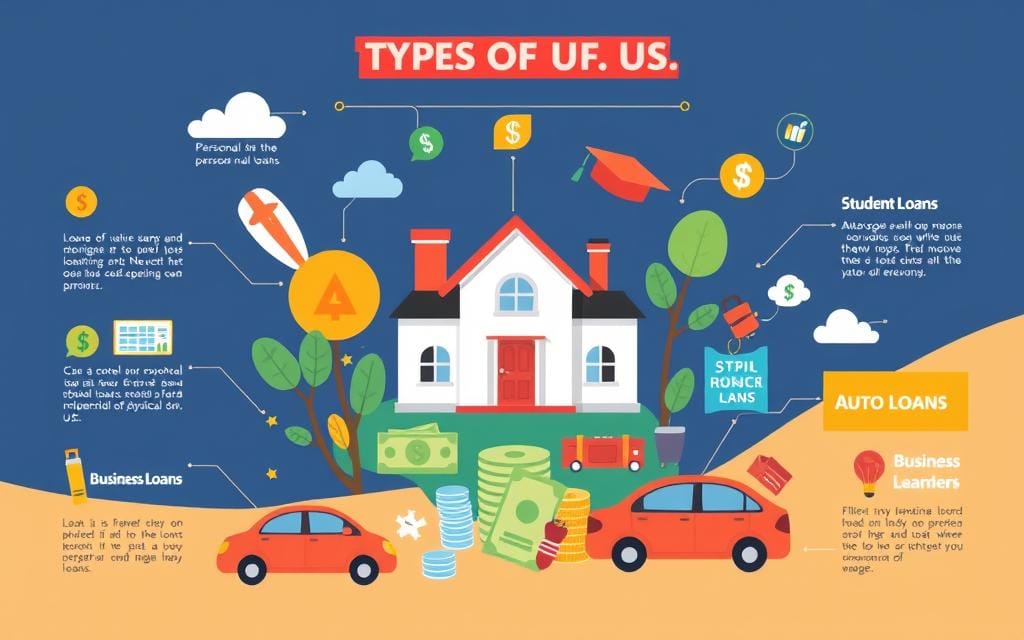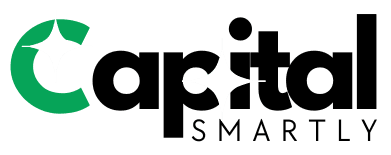advertisement
Americans owe over $17 trillion in loans. The loan landscape in the U.S. is vast and diverse. Understanding loan types can help you make smart financial choices.
This guide explores the main types of loans in the U.S. We’ll cover their key features and best uses. You’ll learn how to pick the right loan for your needs.

U.S. loan options fit many financial needs. These include mortgages, car loans, and personal loans. Each type has its own benefits and drawbacks.
We’ll look at how different loans can help you reach your goals. You’ll gain knowledge to navigate the world of lending. This info will help you make the best choice for your situation.
What are the Main Types of Loans Available in the U.S.?
The U.S. offers many loan options to meet people’s financial needs. These range from personal loans to mortgages and business loans. Let’s explore the main types of loans and their impact on lending history.
Overview of Loan Categories
The most common loan categories in the U.S. include:
- Personal Loans: Versatile financing options for personal expenses, debt consolidation, or unexpected costs.
- Mortgage Loans: Loans used to purchase or refinance a home, with various products like fixed-rate, adjustable-rate, and jumbo mortgages.
- Auto Loans: Financing for the purchase of new or used vehicles, often provided by dealerships or banks.
- Student Loans: Both federal and private loans to help cover the costs of higher education.
- Business Loans: Financing solutions for entrepreneurs and small businesses, including term loans, lines of credit, and SBA loans.
Brief History of Loans in the U.S.
Lending in the U.S. has changed over time. It reflects the country’s economic growth and people’s changing financial needs. In colonial times, lending was based on personal relationships and limited by available capital.
As the nation grew, banking and loan products expanded. They catered to the rising demand for real estate, business, and consumer financing. The 20th century saw specialized loans emerge, like auto and student loans.
Government-backed loan programs also appeared to support homeownership and small businesses. Now, the U.S. lending market is a complex system. It offers many loan options for various financial needs.
| Loan Type | Purpose | Typical Uses |
|---|---|---|
| Personal Loan | Versatile financing | Personal expenses, debt consolidation, emergencies |
| Mortgage Loan | Home financing | Home purchase, refinancing, home equity |
| Auto Loan | Vehicle financing | New or used car, SUV, or truck purchase |
| Student Loan | Education financing | Tuition, fees, room and board, textbooks |
| Business Loan | Business financing | Startup costs, expansion, equipment, working capital |
Personal Loans: A Flexible Financial Solution
Personal loans offer a versatile option for those seeking flexible financing. Banks, credit unions, and online lenders provide these unsecured loans. They’re an attractive choice for various financial needs.
Characteristics of Personal Loans
Personal loans have fixed interest rates and set repayment terms. They don’t require collateral, making them accessible to many borrowers. Users can expect predictable monthly payments and freedom to use funds as needed.
These loans can be used for debt consolidation, home improvements, or unexpected expenses. Their flexibility makes them suitable for a wide range of financial situations.
When to Consider a Personal Loan
- Debt Consolidation: Personal loans can combine multiple high-interest debts into one manageable monthly payment. This often results in a lower overall interest rate.
- Home Improvements: Use a personal loan to renovate your kitchen, upgrade your bathroom, or tackle larger projects. No home equity is required.
- Unexpected Expenses: Personal loans can help with surprise medical bills, car repairs, or other financial emergencies.
Applying for a personal loan involves providing personal and financial information. This includes your credit score, income, and debt-to-income ratio. Lenders use this data to evaluate your creditworthiness.
Based on your information, lenders determine loan terms. These include the interest rate and repayment period. Your financial profile greatly influences these factors.
| Loan Type | Interest Rates | Repayment Terms | Collateral Required |
|---|---|---|---|
| Personal Loans | 6% – 36% | 1 – 7 years | None |
Personal loans offer a flexible solution for various financial needs. They can help with debt consolidation, home projects, or unexpected expenses. Understanding their features helps you make informed decisions aligned with your financial goals.
Mortgage Loans: Understanding Home Financing
Buying a home is a big financial step for many Americans. Understanding mortgage loans can help you make smart choices about home financing.
Learning about different mortgage options and common terms is key. This knowledge will guide you in finding the right loan for your needs.
Different Types of Mortgage Loans
The U.S. mortgage market offers various loan options. These cater to different financial situations and needs.
- Conventional Loans: These are standard mortgage loans that are not insured by the government. They typically require a down payment of at least 20% of the home’s value.
- FHA Loans: Backed by the Federal Housing Administration, these loans are designed for first-time and low-income homebuyers, often requiring a down payment as low as 3.5%.
- VA Loans: Available to eligible members of the U.S. military and their families, VA loans offer competitive interest rates and may not require a down payment.
- USDA Loans: Offered by the U.S. Department of Agriculture, these loans are geared towards low-income borrowers in rural or suburban areas, with no down payment required.
Common Terms in Mortgage Agreements
Mortgage agreements use many important terms. Knowing these terms helps you understand your loan better.
- Principal: The total amount borrowed, excluding interest and fees.
- Interest: The cost charged by the lender for borrowing the principal amount.
- Taxes: Property taxes that must be paid as part of the monthly mortgage payment.
- Insurance: Homeowner’s insurance and, if applicable, private mortgage insurance (PMI) or other required coverage.
Fixed-rate and adjustable-rate mortgages are two main types. Fixed-rate mortgages keep the same interest rate throughout the loan.
Adjustable-rate mortgages can change based on market conditions. This may affect your monthly payments over time.
Learning about mortgage options and terms helps you navigate home financing. This knowledge empowers you to find the best solution for your needs.
Auto Loans: Financing Your Vehicle
Auto loans are crucial for vehicle purchases. Understanding different loan types and approval factors helps you make smart choices. You can secure the best financing for your new or used car.
Types of Auto Loans
Several auto loan options exist for U.S. consumers. The most common choices include:
- Dealership Financing: Car dealerships offer loans through lending partnerships. These are convenient but compare offers for the best rates and terms.
- Bank Loans: Traditional banks and credit unions provide auto loans. They may offer better rates, especially for those with good credit.
- Online Lenders: These platforms offer quick applications and may finance borrowers with less-than-perfect credit.
Key Factors in Auto Loan Approval
Lenders consider several factors when approving auto loans. These determine your eligibility and loan terms.
- Credit Score: Your credit score is a key factor. It helps lenders assess your creditworthiness and loan risk.
- Income and Debt-to-Income Ratio: Lenders evaluate your income and debts. They ensure you can afford the monthly loan payments.
- Collateral: The vehicle serves as collateral. Lenders consider its make, model, and age when setting loan terms.
Knowing these factors helps you prepare for the loan process. It can boost your chances of getting good financing.
| Loan Type | Advantages | Disadvantages |
|---|---|---|
| Dealership Financing | Convenient, can often be bundled with vehicle purchase | May have higher interest rates compared to other options |
| Bank Loans | Potentially lower interest rates, more flexibility in loan terms | Requires separate application and approval process from vehicle purchase |
| Online Lenders | Streamlined application process, may accommodate borrowers with lower credit scores | May have higher interest rates or less flexible terms compared to traditional lenders |
Grasping auto loan types and approval factors is key. It helps you navigate financing with confidence. You’ll find the best solution for your needs.
Student Loans: Funding Education in the U.S.
Student loans are vital for funding higher education in the United States. They help manage the hefty financial burden of college. It’s crucial to understand the differences between federal loans and private loans.
Federal vs. Private Student Loans
The U.S. government offers federal student loans with favorable terms and repayment options. These include Direct Subsidized Loans, Direct Unsubsidized Loans, and Direct PLUS Loans.
Banks, credit unions, and other financial institutions provide private student loans. These loans may offer extra funding but often have higher interest rates. They also tend to have less flexible repayment plans than federal loans.
Repayment Options and Forgiveness Programs
Student loan repayment can be complex, but various options exist for borrowers. Income-driven repayment plans can make monthly payments more manageable. These plans are based on the borrower’s income and family size.
Student loan forgiveness programs offer relief for some borrowers. Public Service Loan Forgiveness and Teacher Loan Forgiveness may forgive part of the loan. Borrowers must meet specific criteria to qualify for these programs.
Understanding student loans and repayment strategies is key. It helps borrowers make smart decisions about their education and finances. This knowledge can minimize the long-term impact of education financing.
Business Loans: Supporting Your Enterprise
The right business loan can boost your enterprise’s growth and success. Various options are available for startups and established companies. These loans are designed to meet your specific financing needs.
Types of Business Loans
Business loans come in diverse forms. Term loans offer upfront lump-sum payments with fixed repayment periods. They often have fixed interest rates.
Business lines of credit provide flexible access to funds. You can draw and repay as needed. This option offers more flexibility.
Small Business Administration (SBA) loans are backed by the U.S. government. They often have favorable terms and lower interest rates for qualified small businesses.
How to Qualify for a Business Loan
Lenders evaluate several factors when considering loan applications. These include your credit score, time in business, annual revenue, and collateral.
A healthy credit profile and strong profitability track record can boost your chances. Having sufficient assets for collateral also helps. Understanding specific loan requirements can help you present a compelling case.
| Loan Type | Credit Score Requirement | Time in Business | Annual Revenue |
|---|---|---|---|
| Term Loan | 640+ | 1+ year | $50,000+ |
| Business Line of Credit | 680+ | 6+ months | $100,000+ |
| SBA Loan | 640+ | 2+ years | $200,000+ |
Requirements may vary based on lender and loan type. Consult a financial advisor for personalized guidance. Explore multiple lenders to find the best fit for your business needs.
Secured vs. Unsecured Loans: Key Differences
Borrowers often choose between secured and unsecured loans. Each type has unique features that affect your financial decision. Let’s explore the main differences to help you pick the right option.
Understanding Secured Loans
Secured loans require collateral, like a house or car. This asset guarantees the loan, reducing the lender’s risk. As a result, secured loans usually offer lower interest rates.
Exploring Unsecured Loan Options
Unsecured loans don’t need collateral. They rely on your creditworthiness and financial history. Lenders take more risk, so unsecured loans often have higher interest rates.
Consider the loan amount and purpose when choosing. Secured loans suit larger purchases or investments. Unsecured loans work better for smaller, immediate needs.
| Secured Loans | Unsecured Loans |
|---|---|
| Require collateral (e.g., home, car) | Do not require collateral |
| Lower interest rates | Higher interest rates |
| Lender has less risk due to collateral | Lender takes on more risk without collateral |
| Suitable for larger purchases or investments | Suitable for smaller, immediate financial needs |
Knowing these differences helps you make smart choices. Pick the loan that fits your financial goals and situation best.
Loan Types for Bad Credit: Options Available
Bad credit can make borrowing difficult. However, there are loan options for those with low credit scores. Bad credit loans, low credit score financing, and credit-builder loans are worth exploring.
Alternatives for Borrowers with Low Credit Scores
- Secured credit cards: These cards require a refundable security deposit, which becomes the credit limit. They can help build credit over time.
- Credit-builder loans: These small loans are designed to help individuals with poor credit establish a positive payment history, which can improve their credit scores.
- Cosigned loans: Borrowers with low credit scores can apply for a loan with a cosigner, usually a family member or friend with a good credit history, to improve their chances of approval.
Impact of Bad Credit on Interest Rates
Bad credit often leads to higher interest rates on loans. Lenders see these borrowers as riskier. This can make securing favorable loan terms more difficult.
Higher interest rates result in increased borrowing costs. Understanding this impact is crucial when exploring bad credit loan options.
“Improving your credit score is key to accessing more favorable loan terms and interest rates, which can save you thousands of dollars over the life of a loan.”
Exploring alternatives for bad credit borrowers is important. Understanding how credit scores affect loan terms helps make informed decisions.
These steps can help rebuild financial health over time. It’s a journey, but one that can lead to better borrowing options.
Government Loans: What They Are and Who Qualifies
Government-backed loans offer a unique financing option. These special programs help specific groups achieve their financial goals. They’re designed for home buying, vehicle financing, or funding education.
Overview of Government-Backed Loans
Federal agencies back government loans, providing guarantees to lenders. This reduces the risk of default, making lenders more willing to offer these loans.
These programs aim to make financing more available and affordable. They’re ideal for those who might not qualify for traditional loans.
Eligibility Requirements for Government Loans
- FHA Loans: Intended for first-time and low-to-moderate income homebuyers, FHA loans require a minimum down payment of 3.5% and have more lenient credit requirements compared to conventional mortgages.
- VA Loans: Available to active-duty military personnel, veterans, and their eligible spouses, VA loans offer 100% financing with no down payment and competitive interest rates.
- USDA Loans: Designed to support rural and suburban homebuyers, USDA loans provide 100% financing and are available to low-to-moderate income individuals in designated rural areas.
Borrowers must meet specific eligibility criteria set by respective agencies. These include income limits, credit score thresholds, and property location requirements.
It’s crucial to research guidelines for the government loan program you’re interested in. Each program has its own application process.
| Loan Type | Eligibility Criteria | Key Benefits |
|---|---|---|
| FHA Loans | – First-time or low-to-moderate income homebuyers – Minimum credit score of 500 (580 for 3.5% down) | – Low down payment (3.5%) – Flexible credit requirements |
| VA Loans | – Active-duty military, veterans, and eligible spouses | – 100% financing (no down payment) – Competitive interest rates |
| USDA Loans | – Low-to-moderate income borrowers in designated rural areas | – 100% financing (no down payment) – Income limits apply |
Understanding different types of government loans is crucial. It helps borrowers make informed decisions about their financing options.
These loans can provide access to financing that suits unique financial situations. They’re designed to help achieve various financial goals.
How to Choose the Right Loan Type for Your Needs
Finding the best loan can be tricky. But with the right approach, you can find a financing solution that fits your goals. The key is to assess your financial situation and consider factors that influence your borrowing decisions.
Assessing Your Financial Situation
Start by looking at your current finances. This means checking your income, expenses, and long-term money goals. Understanding your cash flow and debt-to-income ratio is crucial.
These factors help determine your financial stability. With this info, you can choose the best loan selection for your needs.
Factors to Consider When Choosing a Loan
Several factors shape the best loan option for you. These include interest rates, repayment terms, fees, and loan purpose.
- Interest Rates: Compare rates from different lenders to find the most cost-effective option.
- Repayment Terms: Check the loan duration and monthly payments. Make sure they fit your financial abilities.
- Fees and Charges: Look at origination fees, prepayment penalties, and late payment charges. These affect the total loan cost.
- Loan Purpose: Decide if you need the loan for a home, car, or personal needs. This guides you to the right type.
Weigh these factors against your financial situation. This helps you make an informed choice. You’ll be able to select the best loan type for your borrowing decisions.

“Successful loan selection isn’t just about low interest rates. It’s about choosing a financing option that fits your long-term goals and lifestyle.”
The Process of Applying for a Loan in the U.S.
Getting a loan in the U.S. requires careful planning and preparation. Understanding the steps and expectations can help you navigate the process smoothly. Let’s explore the key aspects of loan applications.
Steps to Take Before Applying
Start by reviewing your credit report and fixing any issues. This can boost your chances of loan approval. Check your credit score and address any errors you find.
Next, gather all necessary documents. These include proof of income, employment records, and financial statements. Having these ready will speed up the application process.
What to Expect During the Loan Application Process
After preparation, submit your loan application to the lender. They will conduct a thorough credit check to assess your financial stability. This helps them determine your creditworthiness.
The underwriting process follows. Lenders evaluate your application, verify information, and set loan terms. They’ll decide on interest rates and repayment schedules based on your financial profile.
Remember, requirements may vary among lenders. Being honest and providing accurate information improves your chances of approval. Stay organized and patient throughout the process.
FAQ
What are the main types of loans available in the U.S.?
The main U.S. loan types are personal, mortgage, auto, student, and business loans. Each type serves different financial needs. They have unique features to suit various borrowing situations.
What are the characteristics of personal loans?
Personal loans are usually unsecured, meaning no collateral is needed. They have fixed interest rates and set repayment terms. These loans offer flexibility for debt consolidation, home improvements, or unexpected costs.
What are the different types of mortgage loans?
The main mortgage loans are conventional, FHA, VA, and USDA. They differ in down payment needs and credit score rules. Borrowers can choose the best option for their home financing needs.
What factors influence the approval of an auto loan?
Key factors for auto loan approval include credit score, income, and debt-to-income ratio. The type of vehicle being financed also matters. Lenders use these to assess a borrower’s ability to repay.
What is the difference between federal and private student loans?
Federal student loans are government-funded with better rates and repayment options. They may offer loan forgiveness. Private student loans come from banks or other institutions.
Private loans often have higher rates and less flexible terms.
What types of business loans are available?
Common business loans include term loans, lines of credit, and SBA loans. These vary in purpose, eligibility, and terms. They cater to diverse financing needs of entrepreneurs and small businesses.
What is the difference between secured and unsecured loans?
Secured loans require collateral, like a home or vehicle. Unsecured loans don’t need collateral and depend on creditworthiness. Secured loans usually offer lower interest rates.
Unsecured loans tend to have higher rates due to increased risk.
What loan options are available for borrowers with bad credit?
Options for poor credit include secured credit cards, credit-builder loans, and cosigned loans. These can help rebuild credit and access financing. However, they often have higher rates or extra requirements.
What are government-backed loan programs, and who qualifies for them?
Government-backed loans like FHA, VA, and USDA make homeownership more accessible. They offer easier credit criteria and lower down payments. Eligibility depends on factors like military service, income, or location.
How can I choose the right loan type for my needs?
Assess your financial situation, including income, expenses, and long-term goals. Consider interest rates, repayment terms, fees, and the loan’s purpose. Evaluating these factors helps select the best loan for your needs.
What should I expect during the loan application process?
The loan process involves checking your credit, gathering documents, and submitting an application. Lenders will review your creditworthiness and income. They use this to determine your eligibility and loan terms.



